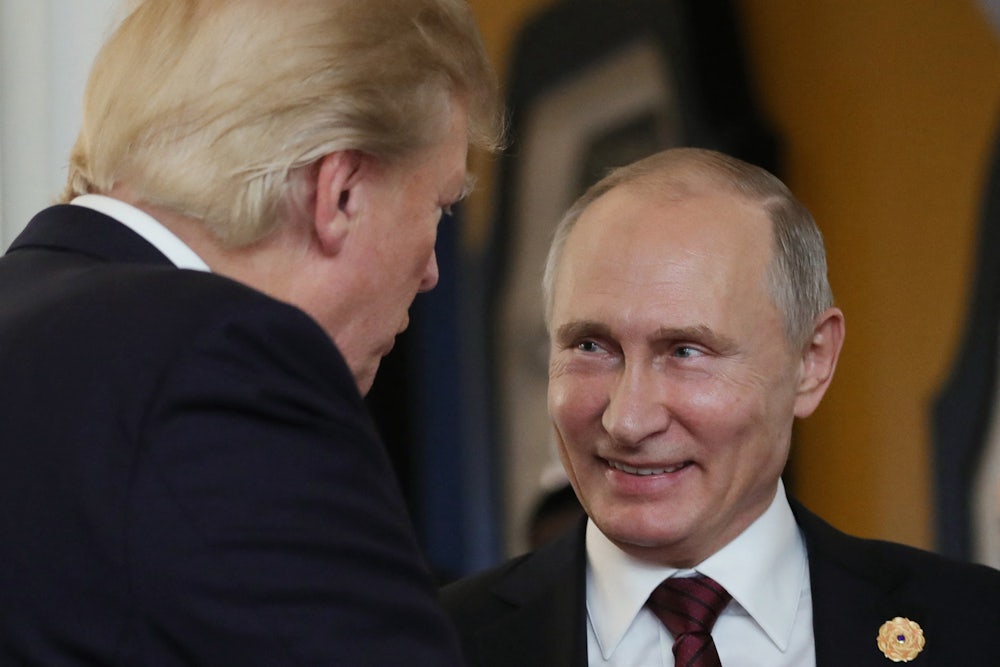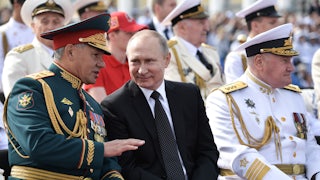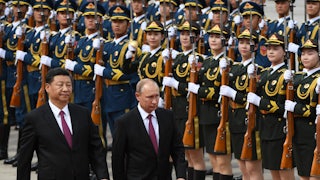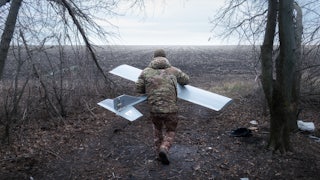Most Americans think that Russian President Vladimir Putin would not have invaded Ukraine if Donald Trump were president. That news comes via a Harvard Center for American Political Studies-Harris Poll survey released last Friday, which said 62 percent of those polled believed Putin would not have attacked Ukraine if Trump were still in office—numbers that strongly suggest that most Americans still have little understanding about the disastrous ramifications of the Trump-Russia relationship.
Putin, you may recall, famously regards the death of the Soviet Union as the “greatest catastrophe” in history and has the larger ambition of not just taking back Ukraine but also rolling back all the advances by NATO since the collapse of the USSR. And it just happens that the most powerful weapon ever devised to subvert NATO was Trump, who had been doing an extraordinarily effective job of crippling NATO from within and planned to shatter it in his second term.
Indeed, Trump, whom the KGB sought to cultivate as an asset more than 40 years ago, who played a role in laundering millions, perhaps hundreds of millions, of dollars for the Russian mafia, and who was bailed out of bankruptcy repeatedly by Russian and former Soviet operatives, has, in words and actions, spent four decades trying to implement one and only one overriding foreign policy goal: Destroy NATO.
Consider:
In 1980, the KGB first began cultivating Trump as an intelligence asset when Semyon Kislin, a Soviet émigré who co-owned the Joy-Lud electronics store in New York, sold Trump hundreds of TV sets for a new hotel. As I documented in American Kompromat, according to Yuri Shvets, a former major in the KGB, Kislin allegedly worked as a so-called “spotter agent” while running the store and identified Trump as a potential asset. (Kislin denies that he had a relationship with the KGB.)
In 1984, a year after opening Trump Tower, Donald Trump sold five condos in his glitzy luxury high rise in an all-cash transaction of $6 million ($28 million in 2022 dollars) to David Bogatin, an alleged member of the Russian mafia. According to the New York State attorney general’s office, Trump had, knowingly or not, just laundered money for the Russian mob.
In the years that followed, as I reported in The New Republic, at least 13 people with known or alleged links to Russian mobsters or oligarchs owned, lived in, and even ran criminal activities out of Trump Tower and other Trump properties.
In addition, according to a Buzzfeed investigation, more than 1,300 Trump-branded condos were sold “in secretive all-cash transactions that enable buyers to avoid legal scrutiny by shielding their finances and identities.” Anonymity and all-cash transactions are the two essential predicates for money laundering. The total value of the condos sold was around $1.5 billion, but that figure did not even include many other Trump-branded properties in Canada, the Philippines, Panama, Turkey, India, South Korea, and other countries where similar transactions may have been taking place.
Meanwhile, in 1986, Trump met with Soviet Ambassador Yuri Dubinin and his daughter Natalia Dubinina, who worked at the U.N.’s Dag Hammarskjöld Library, in a job that was widely known to be a cover for KGB operatives. Dubinina and her father told Trump how much they loved Trump Tower and would love to have him develop a Trump Tower Moscow.
In early 1987, KGB Major Yuri Shvets, based in Washington, returned to Yasenevo, the headquarters for the KGB’s (now SVR) foreign intelligence operations, to engage a new recruit from the United States in “active measures,” including propaganda and disinformation campaigns against the West. At the time, according to Shvets, in addition to its ongoing war against NATO, the KGB was disseminating active measures designed to disrupt America’s alliance with Japan.
In July 1987, a few months later, the KGB orchestrated Trump’s first trip to the Soviet Union. According to Shvets, the letter inviting Trump was written at the behest of Ivan Gromakov, a KGB general in the First Chief Directorate’s rezidentura in Washington. In late summer 1987, just weeks after returning from the Soviet Union, Trump began an abortive campaign to win the 1988 Republican nomination and set up appearances in New Hampshire for the primary season.
A few days later, Shvets received a cable instructing KGB agents “to show us examples of craftsmanship in recruitment, in analytical work, examples to follow.” This cable pointed to a successful active-measure operation by which full-page ads voicing KGB talking points were printed in the Boston Globe, The Washington Post, and The New York Times under the headline, “There’s Nothing Wrong With America’s Foreign Defense Policy That a Little Backbone Can’t Cure.”
The ads put forth a foreign policy that, for all practical purposes, called for the dismantling of the postwar Western alliance and the end of NATO. They took the form of an open letter to the American people “on why America should stop paying to defend countries that can afford to defend themselves.”
The ad said: “The world is laughing at America’s politicians as we protect ships we don’t own, carrying oil we don’t need, destined for allies who won’t help. It’s time for us to end our vast deficits by making Japan, and others who can afford it, pay. Our world protection is worth hundreds of billions of dollars to these countries, and their stake in their protection is far greater than ours.”
The ads were signed by none other than Donald Trump, as part of his abortive presidential campaign. “The ad was assessed by the active measures directorate as one of the most successful KGB operations of that time,” Shvets told me in 2020, when I interviewed him for American Kompromat. “It was a big thing—to have three major American newspapers publish KGB sound bites.”
In the late 1980s and early 1990s, Trump had one business failure after another in airlines, football, and other sectors as he overexpanded into Atlantic City casinos and accumulated enormous debt. In 1996, Trump visited Russia again, hoping to revive dreams of Trump Tower Moscow.
In 2002, the Bayrock Group, a real estate firm staffed by émigrés from Russia and the former Soviet Union, began to bail Trump out with lucrative schemes that paid huge sums to license his name for luxury condos. The developments were financed by Bayrock and its associates who had ties to the Kremlin and Russian intelligence and, allegedly, the mob. Among its projects, Bayrock planned to develop the Trump SoHo in New York and other Trump-branded luxury high-rises in Fort Lauderdale, Phoenix, and elsewhere.
In the wake of the 2008 fiscal crisis, Trump expanded into developing golf courses. According to his son, Eric Trump, the funding came from Russia.
In 2013, Trump staged the Miss Universe Pageant in Moscow, financed and produced by Aras Agalarov, a Putin-aligned oligarch.
On March 29, 2016, Paul Manafort joined the Trump campaign as campaign manager. Long known as an operative in the so-called “Torturers’ Lobby,” where he and Roger Stone represented repressive governments in Kenya, Nigeria, the Philippines, and elsewhere, Manafort had begun working for Russian oligarch Oleg Deripaska in 2004. In the ensuing years, his operation received $75 million from pro-Putin oligarchs. Manafort worked in Ukraine with Russian intelligence operative Konstantin Kilimnik as his chief assistant. In 2010, Manafort acted as the political campaign manager and agent for Viktor Yanukovych, who was elected president of Ukraine but was exposed to be a Putin puppet. He was ousted in 2014 after the bloody revolt in Maidan Square and fled to Russia.
In April 2016, after Trump had won a series of primaries, he staged his first event presenting his foreign policy at the Mayflower Hotel in Washington, hosted by Dmitri Simes, a Russian who worked in U.S. think tanks. Yuri Shvets told me that when he was still in the KGB, he crossed paths with Simes at the press center of the Ministry of Foreign Affairs in Moscow and wanted to recruit him on the spot. “I saw Simes, and he was always lonely,” said Shvets. “Americans didn’t talk to him. Soviets didn’t talk to him.”
Shvets discussed the matter with his superior, who wanted to check it out with headquarters. “And the next day, he calls me saying, ‘Stand down. He’s being taken care of,’” Shvets told me. Translation: There was no need to recruit Simes because he was already a contact of the KGB. Simes currently hosts a political show on Channel One Russia, a state-controlled channel.
Before long, the Trump-Russia alliance went full steam ahead. On June 9, 2016, Donald Trump Jr., Jared Kushner, and Paul Manafort met with several Russian operatives, including Emin Agalarov and Natalia Veselnitskaya, in Trump Tower in hopes of getting dirt on Democratic nominee Hillary Clinton. That July, at the GOP convention in Cleveland, Team Trump famously weakened the Ukraine plank of the Republican platform, removing language that called for “providing lethal defensive weapons” and replacing it with the phrase “appropriate assistance.” On July 27, 2016, Trump asked Russia to find Hillary Clinton’s missing emails: “Russia, if you’re listening, I hope you’re able to find the 30,000 emails that are missing,” Trump said. He added, “I think you will probably be rewarded mightily by our press.”
On August 19, 2016, Manafort resigned from the Trump campaign following press articles related to his work for Yanukovych. Later, in a text message that was hacked from her phone, Manafort’s daughter Andrea Manafort Shand asserted that her father’s resignation was merely a ruse to appease the public. “As I suspected, my dad resigned from being the public face of the campaign but is still very much involved behind the scenes,” she wrote a friend. “He felt he was becoming a distraction and that would ultimately take a toll on the campaign.”
On October 11, 2016, Donald Trump Jr. was paid $50,000 plus to give a speech in Paris sponsored by Center of Political and Foreign Affairs, a French think tank that is said to be a Russian front. Afterward, according to The Wall Street Journal, the CPFA’s Randa Kassis told Don Jr. that it was essential to cooperate with Russia in the Middle East. Then she quickly flew to Moscow, where she met with Foreign Minister Sergei Lavrov, with whom, The Guardian reported, she is good friends. As Kassis explained in a Facebook post, “I succeeded to pass [to] Trump, through the talks with his son, the idea of how we can cooperate together to reach the agreement between Russia and the United States on Syria.” Later, in 2019, President Trump did exactly as the Russians hoped, removing U.S. troops from northern Syria and leaving Russia as the clear winner.
On May 10, 2017, after firing FBI Director James Comey for investigating his ties with the Russians, Trump celebrated in the Oval Office with Russian Foreign Minister Sergey Lavrov and Russian Ambassador Sergey Kislyak. According to The Washington Post, during the meeting, Trump revealed highly classified information to the Russians, making disclosures that jeopardized a critical source of intelligence on ISIS.
In his report on Russian interference in the 2016 election, Robert Mueller did not charge Trump with obstruction of justice, instead deferring to the policy of not charging a sitting president. Nevertheless, according to CBS News, he cited 10 instances in which Trump may have committed “discrete acts” of obstruction. In addition, the Mueller report concluded that “Trump and 18 of his associates had a least 140 contacts with Russian nationals and WikiLeaks, or their intermediaries during the 2016 campaign and presidential transition,” The New York Times reported.
On July 16, 2018, in Helsinki, Trump met with Putin and defended Russia against the U.S. intelligence community’s finding that Russia interfered in America’s 2016 presidential election. “President Putin says it’s not Russia,” Trump said. “I don’t see any reason why it would be.”
Then came the events that led to Trump’s first impeachment. In January 2019, Trump ally Rudy Giuliani met in New York with the top Ukrainian prosecutor at the time, Yuriy Lutsenko, in an effort to dig up dirt on Joe Biden and his son, Hunter. On April 7, on Fox News, Rudy Giuliani asserted falsely that Vice President Biden had pressed Ukraine to stop investigating Burisma, a Ukrainian gas company on which Biden’s son Hunter was a board member. There was no evidence to support his claim. In fact, as vice president, Biden called for the removal of then–chief prosecutor Viktor Shokin because he had been so ineffective in taking on corruption in Ukraine.
On April 21, 2019, Volodymyr Zelenskiy was elected president of Ukraine, and two months later, on June 21, Giuliani tweeted that Zelenskiy was “silent on investigation of Ukrainian interference in 2016 election and alleged Biden bribery.”
Then, in July 2019, according to The Washington Post, Trump blocked nearly $400 million in military aid to Ukraine. In written testimony, Ambassador Bill Taylor said he was on a video conference with National Security Council staff and other officials that day when someone from the Office of Management and Budget chimed in and “said that she was from OMB and that her boss had instructed her not to approve any additional spending of security assistance for Ukraine until further notice.” According to Taylor, she said, “The directive had come from the President to the Chief of Staff to OMB.”
Then, on July 25, from 9:03 a.m. to 9:33 a.m., Trump and Zelenskiy spoke in what Trump later called a “perfect phone call.” According to the Ukrainian readout of the call, the two leaders discussed “investigation of corruption cases.” While on the call, Zelenskiy mentioned his government’s need to purchase anti-tank missiles from the U.S., according to a rough transcript of the call released by the White House. Trump responded, “I would like you to do us a favor though.” He asked Zelenskiy to investigate Biden, and said he should talk to Giuliani and Attorney General Bill Barr.
On August 12, the inspector general for the intelligence community, Michael Atkinson, received an anonymous whistleblower complaint alleging that “the President of the United States is using the power of his office to solicit interference from a foreign country in the 2020 U.S. election.”
On December 18, 2019, Trump was impeached by the House of Representatives for soliciting foreign interference from Ukraine to help his reelection bid and obstructing the congressional inquiry by telling administration officials to ignore subpoenas and not cooperate. The votes on the charge were 230 in favor of Trump’s impeachment, 197 against, and one present. In February 2020, however, he was acquitted by the Senate.
When Biden was elected president in November 2020, Putin lost perhaps the most valuable asset the Soviet Union or Russia had ever had—a president of the United States who had been an unparalleled asset for 40 years. Trump had demonized NATO as early as 1987, provided a glitzy and luxurious home away from home for countless Russian alleged mafiosi and operatives for decades, was deeply indebted to the Russians financially, and was, according to the Senate Intelligence Committee report in 2020, the subject of Russian kompromat about his intimate conduct within Russia.
Trump was everything Putin could have wished for, but now he was gone. And so, in Trump’s absence, Putin invaded neighboring Ukraine, thinking, apparently, that NATO was torn asunder, that Biden was crippled thanks to political divisions sown by Trump, that there would be no internal dissent in Russia, that Ukraine was not united, and that his aggression would be a cakewalk.
To which Trump has replied, “This is genius.… Here’s a guy who’s very savvy.… I know him very well. Very, very well. By the way, this never would have happened with us. Had I been in office, not even thinkable. This would never have happened.”
Or so he says.
In their new book, I Alone Can Fix It: Donald J. Trump’s Catastrophic Final Year, Carol Leonnig and Phil Rucker report a more likely outcome, noting that “Trump had privately indicated that he would seek to withdraw from NATO and to blow up the U.S. alliance with South Korea, should he win reelection. When those alliances had come up in meetings with [then–Defense Secretary Mark] Esper and other top aides, some advisers warned Trump that shredding them before the election would be politically dangerous.”
“Yeah, the second term,” Trump had said. “We’ll do it in the second term.”
Similarly, in 2019, The New York Times reported that then-President Trump had said he wanted the U.S. to withdraw from NATO, a move that would have been tantamount to destroying the organization.
But Trump never got his second term (not yet, at least). Putin, no doubt, had planned to rely on Trump to undermine NATO in his second term, and NATO, absent U.S. leadership, would have been far, far less effective in standing up for Ukraine.
Unfortunately for Putin, the greatest useful idiot the Russians ever had was no longer in the White House. So Putin took the gamble without him.








